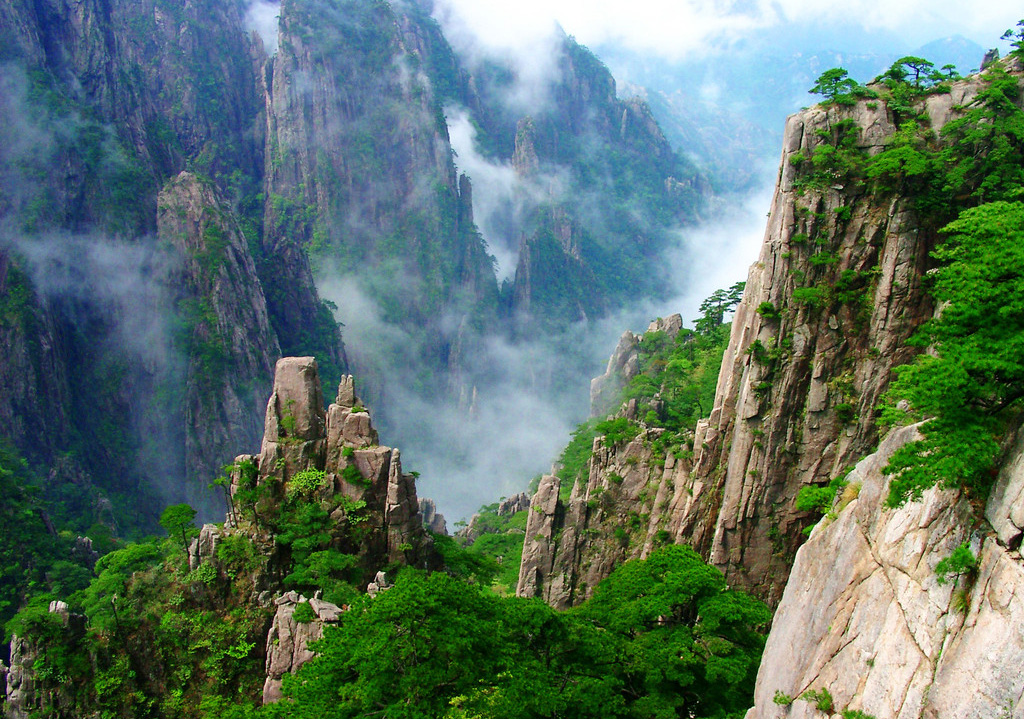The Huangshan Mountain China

Y'all ever heard of Huangshan Mountain in China? It's seriously one of the most beautiful places I've ever seen on this earth. I was blessed to go there on a trip last year and I gotta say, it was worth every penny.
Located within the Anhui province of eastern China, Huangshan Mountain is known for its stunning scenery and distinct granite peaks. The mountain range spans over 150 square kilometers and is characterized by its unique rock formations, lush forests, and hot springs.
But let me tell y'all, getting to Huangshan is no easy feat. You gotta be ready for a journey. We flew into Shanghai and then had to take a 6 hour train ride just to get to the mountain. But trust me, the journey is worth it when you see those views.
One of the highlights of my trip was taking the cable car up to the peak of Huangshan Mountain. The ride itself was breathtaking, with views of the mountains and valleys below. Once we got to the top, we hiked through the various peaks, taking in the scenery and fresh air.
But the journey isn't just about the views. The history behind Huangshan is just as interesting. The mountain has been a source of inspiration for Chinese artists and poets for centuries, with many famous paintings and poems depicting the mountain's beauty. The peaks were named by the poets themselves, with names like "Lotus Peak" and "Celestial Capital Peak".
History of Huangshan Mountain
The history of Huangshan dates back over a thousand years ago, with the mountain being a significant site for Daoism. The famous philosopher, Zhuangzi, often referred to Huangshan in his teachings. It wasn't until later on that the mountain became a popular site for tourism and art.
In the early 20th century, foreign tourists began visiting Huangshan and spreading the word of its beauty. This helped to increase the number of visitors, leading to the development of hotels and transportation to the mountain.
Today, Huangshan Mountain is a UNESCO World Heritage Site and one of the top tourist destinations in China.
Travel Tips
Before you go on your journey to Huangshan Mountain, here are a few travel tips to keep in mind:
- Make sure you have a good pair of hiking shoes. The mountain can be steep and rocky in some areas.
- Be prepared for different weather conditions. Temperatures can vary drastically depending on the time of day and season. Bring layers and rain gear just in case.
- Consider hiring a guide for your hike. They can provide valuable information about the history and culture of the mountain.
- Book your cable car ride in advance to avoid long wait times.
- Bring plenty of snacks and water for the hike. There are a few restaurants on the mountain, but they can be pricey.
FAQ
Here are some common questions people have about visiting Huangshan Mountain:
How much does it cost to visit Huangshan Mountain?
The cost can vary depending on the time of year and how you choose to get there. A cable car ride can cost anywhere from $20 to $60 USD. Hotels and restaurants on the mountain can also be expensive. Overall, expect to spend at least a few hundred dollars for a trip to Huangshan.
Is it safe to hike Huangshan Mountain?
Yes, the trails are generally safe to hike as long as you take necessary precautions. Be aware of steep cliffs and wear appropriate hiking gear. Also, be cautious of the weather conditions, as rain and fog can make the trails slippery.
What is the best time of year to visit Huangshan Mountain?
The best time to visit is in the spring or fall, when the weather is mild and the scenery is at its most beautiful. Avoid the summer months, as the mountain can be very crowded and hot.
What are some other attractions near Huangshan Mountain?
If you have the time, consider visiting some of the nearby cultural sites, such as Hongcun Village and Xidi Village. These ancient villages offer a glimpse into traditional Chinese culture.
So there you have it, my friends. If you ever get the chance to visit Huangshan Mountain, go for it. It's a journey you won't soon forget.



Post a Comment for "The Huangshan Mountain China"